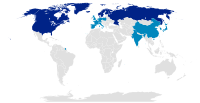
Photo from wikipedia
As an arena of collaborative international governance, the Arctic is relatively young. Arctic states only began meaningfully working together after the fall of the Iron Curtain, and only established the… Click to show full abstract
As an arena of collaborative international governance, the Arctic is relatively young. Arctic states only began meaningfully working together after the fall of the Iron Curtain, and only established the Arctic Council – the ‘most important international forum in the Arctic’ (p. 147) – in 1996. The New Arctic Governance is therefore an apt title for a work analysing this topic. The edited volume proceeds through five chapters examining the following: Arctic security (at the international level and the domestic level for each of the eight Arctic states), Russia’s Arctic policies, Northeast Asia’s burgeoning interest in the region (China, Japan, South Korea) and the Arctic Council. Together, these chapters paint a picture of how the Arctic is being approached and managed. It is astutely noted that Arctic international governance has been shaped by ‘[t]he primary interests of the Arctic states’ in ensuring their sovereignty and regional predominance (p. 4). And ‘[r]ather than compete, [these] states have chosen to cooperate on the basis of international law to achieve these aims’ (p. 4). Accordingly, at present, the Arctic is ‘far from being a battleground’ (p. 16). This does not, however, mean that Arctic governance is free from meaningful challenges. One important issue emanates from the primacy of Arctic states in regional regimes. An example of this is the status of these countries within the Arctic Council: they alone are members with voting power, and they completely dictate the level of participation of non-Arctic states. Such a design was meant to ‘shield regional decision-making, to the extent possible, from non-regional influences’ (p. 184). This has largely been successful but is also problematic. Under international law, all states potentially have ‘legitimate [Arctic] interests and rights’ (p. 183). By effectively denying this, current Arctic governance mechanisms risk being viewed as illegitimate and ignored by nonArctic states as they engage with the region. Increasing Asian interest in Arctic resources and shipping lanes, and corresponding elevated Arctic activity, is highlighting this situation. ‘The challenge is to find a way forward that satisfies the essential interests both of Arctic and non-Arctic states’ (p. 184). Another potential area of concern arises from the fact that ‘[t]he Arctic is not a distinct and unitary security space’ (p. 13). This means that there is always the risk of externally instigated conflicts spilling over into it, particularly given Russia’s substantial presence and role in the region and recent belligerent approach to international affairs. By presenting the aforementioned insights and more, the individual chapters of The New Arctic Governance are shrewd works, and together, they make the book as a whole an engaging examination of its namesake.
Journal Title: Political Studies Review
Year Published: 2017
Link to full text (if available)
Share on Social Media: Sign Up to like & get
recommendations!